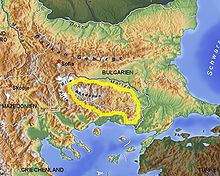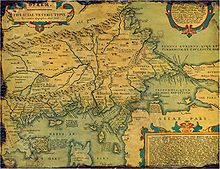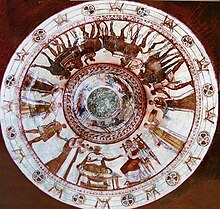Thrace





Thrace (/θreɪs/, thrayss; Bulgarian: Тракия, romanized: Trakiya; Greek: Θράκη, romanized: Thráki; Turkish: Trakya) is a geographical and historical region in Southeast Europe. Bounded by the Balkan Mountains to the north, the Aegean Sea to the south, and the Black Sea to the east, it comprises present-day southeastern Bulgaria (Northern Thrace), northeastern Greece (Western Thrace), and the European part of Turkey (East Thrace), roughly the Roman Province of Thrace. Lands also inhabited by ancient Thracians extended in the north to modern-day Northern Bulgaria and Romania and to the west into Macedonia.
Etymology
The word Thrace, from ancient Greek Thrake (Θρᾴκη),[1] referred originally to the Thracians (ancient Greek Thrakes Θρᾷκες),[2] an ancient people inhabiting Southeast Europe. The name Europe (ancient Greek Εὐρώπη), also at first referred to this region, before that term expanded to include its modern sense.[3][4] The region could have been named after the principal river there, Hebros, possibly from the Indo-European arg "white river" (the opposite of Vardar, meaning "black river"),[5] According to an alternative theory, Hebros means "goat" in Thracian.[6]
In Turkey, it is commonly referred to as
Mythology
In terms of ancient Greek mythology the name appears to derive from the heroine and sorceress
Geography
Borders
The historical boundaries of Thrace have varied. The
Cities
The largest cities of Thrace are:
Demographics and religion
Most of the
Ancient Greek mythology
Ancient Greek mythology provides the Thracians with a mythical ancestor Thrax, the son of the war-god Ares, who was said to reside in Thrace. The Thracians appear in Homer's Iliad as Trojan allies, led by Acamas and Peiros. Later in the Iliad, Rhesus, another Thracian king, makes an appearance. Cisseus, father-in-law to the Trojan elder Antenor, is also given as a Thracian king.
Homeric Thrace was vaguely defined, and stretched from the River
Thrace is mentioned in
The city of Dicaea in Thrace was named after, the son of Poseidon, Dicaeus.[11]
History
Ancient and Roman history

Indigenous
The Thracians recorded no collective name for themselves; terms such as Thrace and Thracians were assigned by the Greeks.[13]
Divided into separate tribes, the Thracians did not form any lasting political organizations until the founding of the
During this period, a subculture of
Sections of Thrace particularly in the south started to become hellenized before the
During the Roman domination, within the geographical borders of ancient Thrace, there were two separate Roman provinces, namely Thrace ("provincia Thracia") and Lower Moesia ("Moesia inferior"). Later, in the times of Diocletian, the two provinces were joined and formed the so-called "Dioecesis Thracia".[17] The establishment of Roman colonies and mostly several Greek cities, as was Nicopolis, Topeiros, Traianoupolis, Plotinoupolis, and Hadrianoupolis resulted from the Roman Empire's urbanization. The Roman provincial policy in Thrace favored mainly not the Romanization but the Hellenization of the country, which had started as early as the Archaic period through the Greek colonisation and was completed by the end of Roman antiquity.[18] As regards the competition between the Greek and Latin language, the very high rate of Greek inscriptions in Thrace extending south of Haemus Mountains proves the complete language Hellenization of this region. The boundaries between the Greek and Latin speaking Thrace are placed just above the northern foothills of Haemus Mountains.[19]
During the imperial period many Thracians – particularly members of the local aristocracy of the cities – had been granted the right of the
Medieval history
By the mid-5th century, as the Western Roman Empire began to crumble, Thracia fell from the authority of Rome and into the hands of Germanic tribal rulers. With the fall of the Western Roman Empire, Thracia turned into a battleground territory for the better part of the next 1,000 years. The surviving eastern portion of the Roman Empire in the Balkans, later known as the Byzantine Empire, retained control over Thrace until the 7th century when the northern half of the entire region was incorporated into the First Bulgarian Empire and the remainder was reorganized in the Thracian theme. The Empire regained the lost regions in the late 10th century until the Bulgarians regained control of the northern half at the end of the 12th century. Throughout the 13th century and the first half of the 14th century, the region was changing in the hands of the Bulgarian and the Byzantine Empire (excluding Constantinople). In 1265 the area suffered a Mongol raid from the Golden Horde, led by Nogai Khan, and between 1305 and 1307 was raided by the Catalan company.[23]
Ottoman period

In 1352, the
Modern history

With the
Today, Thracian is a geographical term used in Bulgaria, Turkey, and Greece.
Notable Thracians
- Ancient Greek mythology, the chief representative of the art of song and playing the lyre.
- Sophism), and (3) that one could not tell if the gods existed or not (see Agnosticism).
- Herodicus was a Greek physician of the fifth century BC who is considered the founder of sports medicine. He is believed to have been one of Hippocrates' tutors.
- atomic theory, the belief that all matter is made up of various imperishable indivisible elements which he called atoms.
- Spartacus was a Thracian who led a large slave uprising in what is now Italy in 73–71 BC. His army of escaped gladiators and slaves defeated several Roman legions in what is known as the Third Servile War.
- A number of Barracks Emperor), from the condition of common soldiers in one of the Roman legions to the foremost positions of political power.
Legacy
The Trakiya Heights in Antarctica "are named after the historical region."[26]
See also
- 1989 expulsion of Turks from Bulgaria
- Celtic settlement of Eastern Europe
- Dacia
- Dardania
- Destruction of Thracian Bulgarians in 1913
- Hawks of Thrace
- Macedon
- Moesia
- Moesogoths
- Music of Thrace
- Paionia
- Thracian treasure
- Turkish Republic of Thrace
Notes
- Perseus Project
- Perseus Project
- ^ "Greek goddess Europa adorns new five-euro note". BBC News. January 10, 2013.
- ISBN 9780511496813. Archived(PDF) from the original on 2022-10-09.
- ISBN 978-9004088641.
- ^ "The Plovdiv Project".
- ^ Swinburne Carr, Thomas (1838). The history and geography of Greece. Simpkin, Marshall & Company. p. 56.
- ^ a b c Smith, Sir William (1857). Dictionary of Greek and Roman geography. London: Little, Brown and Company. p. 1176.
- ^ Johann Joachim Eschenburg, Nathan Welby Fiske (1855). Manual of classical literature. E.C. Biddle. p. 20 n.
- ^ Adam, Alexander (1802). A summary of geography and history, both ancient and modern. A. Strahan. p. 344.
- ^ Stephanus of Byzantium, Ethnica, §D230.
- ISBN 144435163Xp 343
- ISBN 0-521-22717-8,1992, page 597: "We have no way of knowing what the Thracians called themselves and if indeed they had a common name...Thus the name of Thracians and that of their country were given by the Greeks to a group of tribes occupying the territory..."
- ^ A. Sideris, Theseus in Thrace. The Silver Lining on the Clouds of the Athenian-Thracian Relations in the 5th Century BC (Sofia 2015), pp. 13-14, 79-82.
- ^ D. C. Samsaris, Le royaume client thrace aux temps de Tibere et la tutelle romaine de Trebellenus Rufus (Le stade transitif de la clientele a la provincialisation de la Thrace), Dodona 17 (1), 1988, p. 159-168
- ^ [1] D. C. Samsaris, The Hellenization of Thrace during the Greek and Roman Antiquity (Diss. in Greek), Thessaloniki 1980, p. 26-36
- ^ D. C. Samsaris, Historical Geography of Western Thrace during the Roman Antiquity (in Greek), Thessaloniki 2005, p. 7-14
- ^ [2] D. C. Samsaris, The Hellenization of Thrace, passim
- ^ [3] D. C. Samsaris, The Hellenization of Thrace, p. 320-330
- ^ D. C. Samsaris, Surveys in the history, topography and cults of the Roman provinces of Macedonia and Thrace (in Greek), Thessaloniki 1984, p. 131-302
- ^ D. C. Samsaris, Les Thraces dans l' Empire romain d' Orient (Le territoire de la Grèce actuelle). Etude ethno-démographique, sociale, prosopographique et anthroponymique, Jannina (Université) 1993, pp. 372
- ^ D. C. Samsaris, Les Thraces dans l' Empire romain d' Orient (Asie Mineure, Syrie, Palestine et Arabie). Etude ethno-démographique et sociale, VIe Symposium Internazionale di Tracologia (Firenze 11-13 maggio 1989), Roma 1992, p. 184-204 [= Dodona 19(1990), fasc. 1, p. 5-30]
- ^ La Venjança catalana. Gran Enciclopèdia Catalana.
- ^ see footnote 4
- ^ https://www.historystudies.net/trakyanin-yeni-sakinleri -gocmenler-1934-1938_1634
- Composite Antarctic Gazetteer.
References
- Hoddinott, R. F., The Thracians, 1981.
- Ilieva, Sonya, Thracology, 2001
External links
- Ethnological Museum of Thrace, comprehensive website on Thracian history and culture.
- [4] Archived 2021-05-10 at the Wayback Machine Bulgaria's most famous Thracian Treasure - The Panagyurishte Gold Treasure to return home after two years lapse
- Bulgaria's Thracian Heritage. including images of the comprehensive art collection of Thracian gold found on the territory of contemporary Bulgaria.
- Information on Ancient Thrace
- The People of the God-Sun Ar and Areia (modern Thrace) The People of the God-Sun Ar and Areia (Modern Thrace)
- Possible Orphic Lyre rock engraving discovered in Bulgaria's Eastern Rhodope Mountains Archived 2021-05-10 at the Wayback Machine
